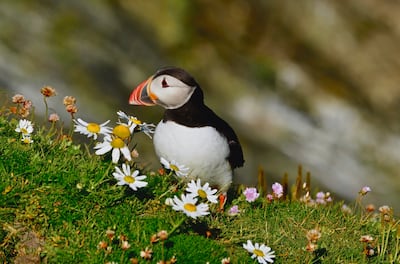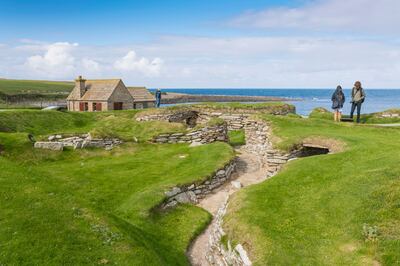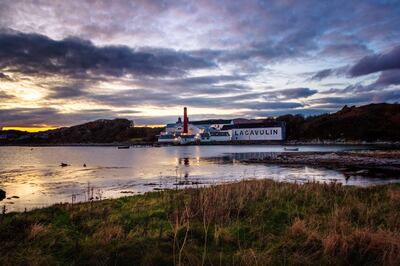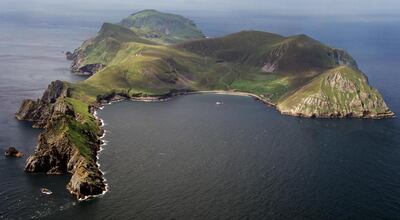Renowned for its natural beauty the world over, Scotland has a new plan to attract more people to live on its far-flung islands.
The Scottish Government’s Islands Bond initiative sets out a proposal to give 100 grants to people moving to the Highlands and Islands.
Bonds of up to £50,000 ($69,670) could be offered to young people and families as part of the plans. The money would be used to help people buy property, build new homes, renovate existing buildings or invest in local businesses on islands across Scotland that are most threatened by depopulation.

The new scheme is currently undergoing a consultation phase, with people from nine island regions, as well as interested parties from across the country and farther afield, invited to fill out the online survey that will be accessible until Sunday, October 24.
If deemed successful after reviewing the findings, the Islands Bond plan would start in 2022.
Islands Secretary Mairi Gougeon said: “Each of our islands are unique and this consultation will help us understand some of the population challenges across our islands and make sure that we can properly address them."
Among the nine island communities listed as part of the consultation phase are Argyll, Arran, Lewis and Harris, Orkney, Shetland, Skye, Uist and Barra.
Preserving Gaelic and island culture

The bond scheme is a key part of the Scottish government’s work towards its National Islands Plan. This five-year proposal is set to help repopulate the country’s most remote islands and preserve island communities and, with it, a dwindling Gaelic culture.
In Scotland’s remote islands, populations are falling. Initial research for the National Islands Plan found that depopulation was the top issue raised by respondents.
In Colonsay, part of the Argyll island region, the current population is less than 130, with no more than 30 people under the age of 50 living there. The island’s only primary school has a register of just four children. On Scalpay, in the Inner Hebrides, less than 30 people call the tiny island home and these are not isolated examples.
A 2020 study from the Office for National Statistics found that rural and island communities were the worst affected by depopulation in Scotland.
That said, the bonds plan is not without its critics, with some people suggesting that it may be better to make money available for communities and local infrastructure plans, rather than given to individuals.
But if you were to apply to be part of the scheme, which of Scotland’s islands would you want to live on?
A guide to Scotland’s remote islands
Known for its rugged landscapes, rocky crags, heather-filled moors and wild surrounding seas, Scotland is home to over 700 islands, each of which has its own personality.
Argyll Islands

Off the west coast of Scotland, the Argyll Islands comprise 23 inhabited islands. From Islay’s peaty pastures famed for making Scotland’s national drink to the remote isle of Jura, where George Orwell wrote 1984 and deer outnumber humans 30 to 1, this is one region well worth a visit.
Don’t miss Iona’s age-old monastery or any of the seven National Nature Reserves, which are the best places to spot golden eagles, red deer, seals, otters and more.
Arran, Bute and the Cumbraes
Scotland’s most accessible island region is easily reached via a short ferry hop from the mainland. Arran is often thought of as Scotland in miniature, as it offers visitors anything they might want from a Scottish island, including sheltered bays, mountain peaks, cultural festivals and plenty of local produce.
Tiny Bute surprises with its tropical palm trees and Victorian-style promenade, surrounded by rolling hills and sandy beaches.
Nearby Great Cumbrae is the place to go for water sports, hiking, cycling and a visit to Britain's smallest cathedral, the Cathedral of the Isles.
Lewis and Harris

Off the west coast of Scotland, in the Outer Hebrides, far-flung Lewis and Harris is well worth the effort it takes to get there. Home to the prettiest beaches in the country, when the sun is shining here you’d be forgiven for thinking you were somewhere more tropical thanks to the island’s pristine shorelines and azure blue waters.
Scenery aside, there’s plenty to see and do, including visiting the Calanais Standing Stones, which are more than 9,000 years old and taking a trip to Stornoway, the largest town in the Outer Hebrides.
Connected to Lewis via a bridge over the Atlantic is Great Bernera, while tiny Scalpay links to Harris via a single-track road. The minuscule Gaelic-speaking island has a population of fewer than 30 people.
Orkney Islands
One of Scotland’s most famous island regions is Orkney, located off the country’s north coast and home to about 70 isles, of which fewer than 20 are inhabited.
On Orkney mainland, you’ll find beaches, dramatic cliffs and endless sea views, plus the town of Kirkwall and age-old Unesco-listed Neolithic sites. Cross the Churchill Barriers to the islands of Burray and South Ronaldsay – once only accessible by boat, but now linked by causeways for a nature-centric excursion. Further afield are several more islands, including Hoy, Papa Westray and Stronsay.
As well as envy-inducing scenery, the archipelago also has impressive wildlife. Seals are in high numbers, especially on the islands of South Ronaldsay, Rousay, and the outer isles, and it’s not uncommon to spot dolphins and whales offshore here, too.
Shetland Islands

Scotland’s most northerly isles lie closer to Norway than to the country’s mainland and the 100-plus islands boast a unique cultural heritage, heavily influenced by a Scandinavian past.
Even the language here is different, with many islanders speaking what’s known as Shetlandic, a regional dialect and a mix between Old Scots and Norse.
Named one of Europe’s top destinations by Lonely Planet in 2019, the islands offer a different slice of Scottish life. Explore Lerwick, the pretty capital, and wander miles of untouched coastline, fringed by towering clifftops, heather-filled moors and rocky crags. Wildlife is abundant here, with everything from seabirds, seals, orcas and, of course, Shetland ponies calling this archipelago home.
And don’t forget Fair Isle, the most remote inhabited island in the UK, known for its bird-spotting opportunities and traditional knitting style.
Uist and Barra
Making up the remainder of the large islands in the Outer Hebrides, the Uist and Barra region spans the sea along the west coast of Scotland and is home to mountains, beaches, bogs and lochs.
North Uist is the biggest island, with visitors arriving via boats at Lochmaddy, once a major fishing port. South Uist is home to rugged peaks, the highest being Beinn Mhor, which towers over the island at a height of 620 metres. The island also has a softer side that's peppered with machair and sandy beaches. The region’s oldest golf course, Askernish, is also found here and offers some of the best and most remote golf course views in the world.
Nearby Barra is the most southerly of the inhabited islands in the Outer Hebrides and is known for its unusual airport, with flights landing on the beach, but only able to do so when the tide is low.
St Kilda

Lying out in the Atlantic, about 60 kilometres from North Uist, is the isolated and most remote island in the British Isles, St Kilda.
Formed from the rim of an ancient volcano, it's home to the westernmost islands of the Outer Hebrides of Scotland. The largest island here is Hirta, which is also Scotland’s first World Heritage Site, having been awarded the title back in 1987. Permanently uninhabited for more than 90 years, it's known for its sheer cliffs and tooth-like sea stacks.






